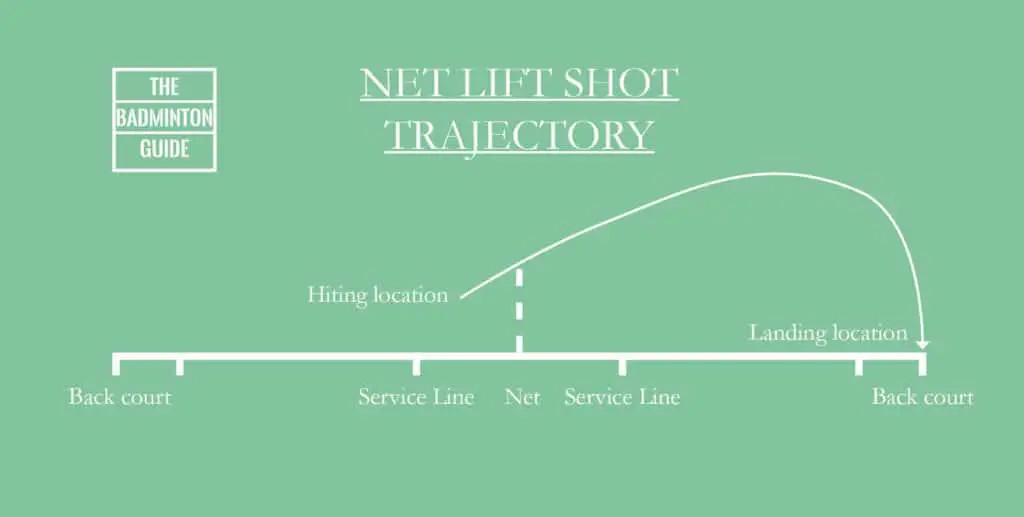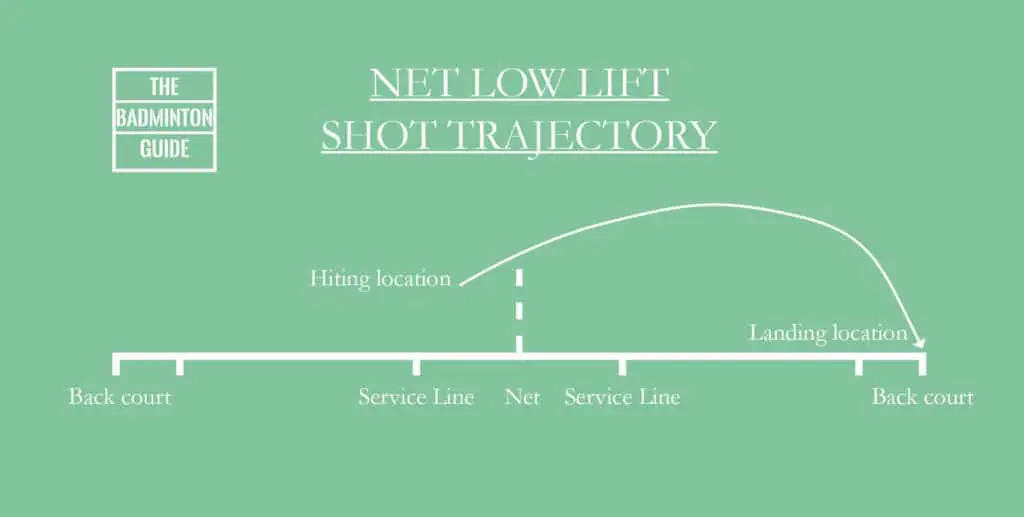Among all badminton shots, the net lift shot is the black sheep. It is seen as very defensive, the easiest to master, and the quick solution that ends up being bad long term. That being said, it is still an important shot to understand and master. Even though it shouldn’t be overused, it can help you throughout your game.
In this post, we are going to clarify what a net lift shot is, and we will describe the different types of net lift shots. After that, we go through a step-by-step process on how to perform the different types of shots. Lastly, we will explain when you would want to use net lift shots and why. Ready? Let’s get started!
Do you want to improve your badminton game? Then be sure to sign up for Badminton Famly+ by clicking here. Founded by former World Champion Thomas Laybourn, Badminton Famly+ is the best online training platform for badminton.
What is a net lift shot in badminton?
A net lift shot is a shot that is performed from the front of the court and directed to the back of the court. It is a defensive shot and it has an upward trajectory.
In the image below you can see the trajectory of a standard net lift shot.

With a net lift shot, you are usually looking for a bit of room to breath, but it can also be used to move your opponent around. Even though it is mostly a defensive shot, it can also finish points as we will see below.
What are the different types of net lift shot in badminton?
There are basically two types of net lift shot, both with a forehand and a backhand variant.
- Net high lift shot
- Net low lift shot
Net high lift shot
This is the most defensive version of this shot. In this case, as you can see in the image below, the shuttle goes very high in order to avoid the net but still managing to reach the back of the court.

This should is used both in singles and in doubles. The more vertical the fall is, the more difficult it will be for your opponent to hit. In singles, you will be using this type of shot when you have received a net shot or a drop shot and you have lost the initiative of the point and you need some time to recover. By sending the shuttle high, you have time to go back to the base position and start from scratch.
In doubles, this is used when you see your chances of doing a successful net shot being very slim. In this case, you also want to send it as high as possible to make the smash more difficult and to have time to position yourself in the court in the defensive formation.
Net low lift shot
This is the offensive version of the shot. Even though it is still a defensive shot because it has an upward trajectory, this shot can help initiatives turn or even win points. In the image below you can see the difference in the trajectory compared to the net high lift shot.

This shot is also used both in singles and in doubles. In this case, you have managed to reach the shuttle still fairly high so the angle of the flight does not need to be so steep. In singles, by sending the shuttle to the back, you can force your opponent to have to move around more, using the movement pressure tactic.
Note: If you are not sure what the movement pressure tactic is, be sure to check our post “What is the Badminton Movement Pressure?“, where we explain it in detail.
In doubles, by sending the shuttle to the back with such a low angle, you can turn the initiative around. You only need to send the shuttle in a way so that, when your opponents reach it, they cannot attack the shuttle and they are forced to give up the initiative.
How to perform a net lift shot?
How to perform a net high lift shot?
Step 1 – Getting ready
The first step is the preparation of the shot or the position you are in before you start with the motion to hit the shuttle. In this position, you should be in the center of the court with your racket leg slightly forward and your non-racket leg slightly backward.
It is very important that your racket is pointing upwards. If your opponent is also in the front of the court, you can bring the racket even a bit more upwards, just in case he/she delivers a weak net shot and you can kill it.
Step 2 – Moving towards the shuttle
While moving towards the shuttle, you need to direct the racket also towards the shuttle. The head of the racket should be higher than your hand in a natural position, so the racket strings should be roughly perpendicular to the court.
You should be making the last step with your racket leg, leaving your non-racket leg behind you. Your non-racket arm should also be extended behind you in order to keep a good balance.
Step 3 – Hitting the shuttle
The last step is hitting the shuttle. Here, you first bring your racket closer to your body by rotating your wrist. This will help you bring power to the shot. Afterward, you should rotate the wrist back while tightening the grip and then follow through with the shot. With all this, make sure the angle of the strings is the correct one so the shuttle goes as high as possible.
While hitting the shuttle, you should be landing with your racket leg. Your legs should be as wide apart as you can without getting stuck or injured.
How to perform a net low lift shot?
Step 1 – Getting ready
This is the same as with the net high lift shot.
Step 2 – Moving towards the shuttle
This is the same as with the net high lift shot, with the exception that you can be holding your racket a bit higher since your aim here is to hit the shuttle as high as possible so the angle of the trajectory is as low as possible.
Step 3 – Hitting the shuttle
Here, as in step two, the underlying principles are the same but there are small variations. Instead of having a racket movement being from down to up, in this case the racket will move a from back to front but without changing its height too much. Moreover, the angle of the strings also needs to be a bit different when hitting the shuttle. In this case, the strings should be almost parallel to the net so that the trajectory is as flat as possible.
When and why would you use a net lift shot?
Now that we know how to perform these shots, it is time to have a look at when we want to use them. We have already hinted that in the first part of the article, but we are going to go a bit more thoroughly here with extra examples.
When and why would you use a net high lift shot?
As I mentioned before, the net high lift shot is a very defensive shot. Therefore, you want to be using it when you are struggling to keep up with the point and you need a bit of time to recover or when all the other alternative shots are very risky because of the situation of all the players in the court.
So, in singles, this is a good shot to perform in the following circumstances.
- Your opponent is moving you around and you are struggling to reach the shuttle all the time. In this case, using a net high lift shot will give you a bit of time to go back to the base position and try to recover a bit the timing of the rally.
- Your opponent has performed an excellent net shot that is going to land very attached to the net and you are not sure you can return a net shot without him/her killing it. In this case, performing a net high lift shot can be quite difficult but, if done correctly, will take you out from a very difficult situation.
In doubles, this is a good shot to perform in the following circumstances.
- Your opponents have the situation under control and you and your partner are struggling to keep a good formation. In this case, performing a net high lift shot will give you two enough time to go back to a good defensive formation.
- Your opponents have performed an excellent net shot that is going to land very attached to the net and you are not sure you can return a net shot without them killing it. In this case, performing a net high lift shot can be quite difficult but, if done correctly, will take you out from a very difficult situation.
When and why would you use a net low lift shot?
The net low lift shot is a more offensive shot. Even though it is still defensive, you can turn around initiatives or even win points with it. This type of shot is the type of shot where you can use a trick shot. Let’s see the situations when you would use this shot.
In singles, you would use this shot as a way to keep moving your opponent around. You have reached one of your opponent’s shots in the net soon enough that you can put some pressure on it. In this case, if you are good with trick shots, using one here is also a good option.
In doubles, you would use this shot as a way to turn the initiative around. If you reach the shuttle high enough that a low lift is a possibility, you should try to do so. With this type of shot, the chances of winning the point are higher than if you did the high lift instead. Keep in mind that in doubles it is all about having the initiative, so the more offensive your shots can be, the better it is.
Final words
And with this, we have arrived at the end of this post. Do you have any lingering doubts about the badminton net shot? Let me know in the comments below.
If you enjoyed this post, you might want to check our Badminton Shots post, where you find a brief explanation and links to all the other types of shots in badminton.
This file is licensed under the Creative Commons Attribution-Share Alike 3.0 Unported license.
Attribution: Marcus Cyron, Wikimedia Commons.
